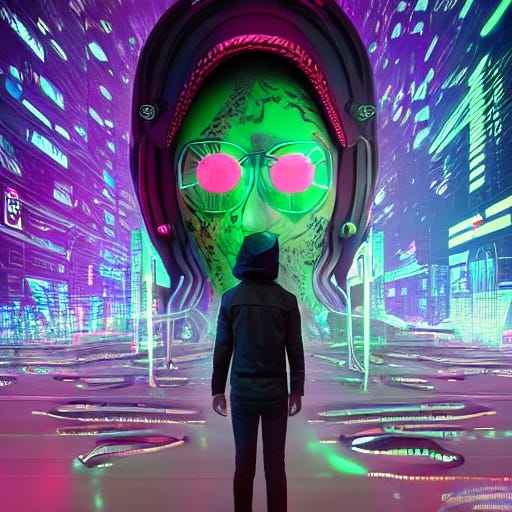As the echoes of Halloween fade away, I find solace in the knowledge that I can finally escape the eerie tunes that haunted our home, including my wife's intriguing rendition of 'Somebody's Watching Me' by Rockwell. This song, known for delving into themes of paranoia and the constant sensation of being under surveillance, mirrors concerns emerging from the realm of generative artificial intelligence (GenAI). The ability of AI to process copious amounts of Internet data a.k.a. the black box, has ignited concerns about privacy and surveillance, while its enigmatic decision-making processes have sown seeds of uncertainty and fear regarding its actions, intentions and interpretations. Just as the song conveys the fear of an unknown observer, discussions about AI often revolve around apprehensions and uncertainties about its capabilities and potential consequences. The similarities between these domains are indeed captivating and deserving of our contemplation.
The Rise of Generative AI and Transformer Architecture
The landscape of artificial intelligence has experienced a monumental transformation, catalyzed by the advent of Generative AI and Large Language Models (LLMs). Transformers are at the forefront of AI innovation. Their ability to process data in parallel, capture context and patterns, and handle multimodal information has led to their widespread adoption in various fields. They serve as the foundation for numerous state-of-the-art applications that have transformed the way we interact with AI and have greatly improved the capabilities of AI systems in understanding, generating, and processing information.
These technologies, typically powered by the Transformer architecture, have revolutionized how we interact with AI, ushering in new possibilities for content creation and communication. However, this shift is not without its complexities and challenges, particularly concerning security.
A recent report from Deloitte highlights the increasing market value driven by AI investments and improved share price returns. The report also predicts that Generative AI is poised to double every other year for the next decade, underscoring the significance of this technology in shaping our future.
The Transformer Architecture: A Double-Edged Sword
Generative AI is driven by the Transformer architecture, a pivotal component of many large-scale AI models. The unique mechanism at the core of the Transformer model, as described in the seminal paper "Attention Is All You Need," revolves around self-attention mechanisms. This feature enables the model to consider the context of each input token in relation to all other tokens in the sequence, resulting in the generation of coherent and contextually relevant output. While this architectural innovation has revolutionized the field of AI and fueled remarkable progress, it also brings forth a host of security challenges and implications.
Challenges: Hallucination
While transformers have brought many advantages, they also present a significant challenge: "hallucination." Transformers, like GPT-4, have the ability to generate text that sounds plausible but is not always factually accurate. They do not function like search engines, providing verified information. Instead, they are pattern-spotting engines that predict the next best word in a sequence. This predictive nature can lead to the generation of fabricated information, including made-up numbers, names, dates, and even entire articles.
There have been reported instances of links to non-existent news articles, incorrect references to research papers, and factual errors in biographies. In some cases, the consequences of this "hallucination" have been quite significant, even leading to legal disputes.
Solutions in the Making
To address these challenges, organizations like Google and OpenAI are working on techniques known as "grounding". Grounding involves cross-checking an LLM's outputs against web search results and providing citations to users for verification. Human feedback is also used to improve the quality of the output, a process known as reinforcement learning by human feedback (RLHF). However, there is still work to be done in understanding how to predict and reduce these hallucinations effectively.
The presence of hallucination as a challenge underscores the need for ongoing vigilance in AI development. Ensuring that the technology generates reliable and accurate information is crucial to prevent the dissemination of false or misleading content. These challenges remind us that while AI has incredible potential, it must be wielded with responsibility and transparency. As we continue to explore the capabilities of transformers and generative AI, we must keep these challenges in mind and work collectively to mitigate them for a more informed and trustworthy future.
Security Implications of Transformer Architecture
1. Data Leakage: The profound contextual understanding of Transformer models makes them highly effective at predicting and generating text. However, this very capability can be misused by malevolent actors to extract sensitive information from the model's responses. Attackers might craft specific inputs aimed at extracting confidential or personal data, emphasizing the need for stringent safeguards.
2. Content Manipulation: Transformer-based Generative AI exhibits a remarkable ability to create exceedingly convincing fake content. Their nuanced comprehension of context allows for sophisticated manipulation, raising concerns about deepfakes, forged documents, and more. This manipulated content can be exploited for various malicious purposes, including disinformation campaigns and fraud.
3. Large-Scale Attacks: The computational intensity required to train and deploy Transformer models renders them attractive targets for cyberattacks. Adversarial attacks on these models could lead to the generation of harmful content on an unprecedented scale. Hence, ensuring the security of these models is paramount to prevent malicious utilization.
4. Bias and Fairness: Even Transformers trained on extensive and diverse datasets can inherit biases present in the training data. This can result in AI-generated content that perpetuates or amplifies existing societal biases, potentially causing harm and raising ethical concerns.
To sum it up, the eerie melodies of "Somebody's Watching Me" may fade away after Halloween, but the resonance of its themes lingers in our discussions about generative AI and security challenges. As AI continues to evolve and integrate into our lives, it is crucial to recognize the potential risks associated with its power and capabilities. The task ahead is to strike a balance between the promise of AI and the imperative to protect privacy, security, and ethical considerations in an age where somebody may indeed be watching – but it might just be AI.


